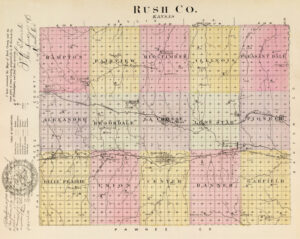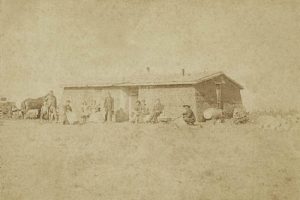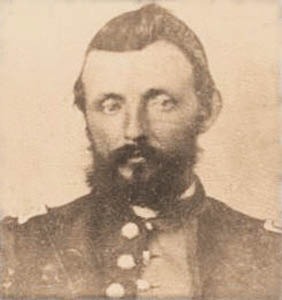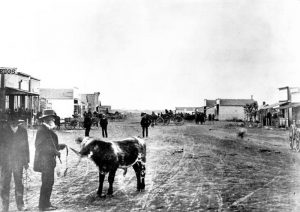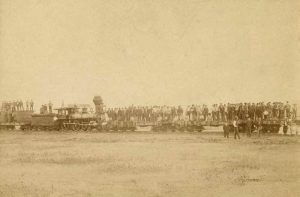Towns
Alexander – Semi-Ghost Town
Bison
La Crosse – County Seat
Liebenthal – Semi-Ghost Town
McCracken
Nekoma – Unincorporated Ghost Town
Otis
Rush Center
Timken – Semi-Ghost Town
Hampton
Hargrave
Loretto
More Extinct Towns
Fort Hays – Fort Larned Trail
Located in the central part of Kansas, the first settlers in what would become Rush County originally lived along Walnut Creek near a trading post and stockade on the Fort Hays—Fort Dodge Trail in the present-day town of Alexander. The gently rolling prairie was filled with wildlife, including deer, pheasant, prairie chickens, coyotes, and buffalo, from which many of the men made their living.
The area was officially surveyed in 1867, and the first claim was filed by P.C. Dixon, who settled on the banks of the Walnut Creek near Walnut City (later Rush Center ) in 1870. Other early settlers were William Basham, Adolph Ashoft, and the family of J.S. Templeton, who came in September 1871. His son was the first white child born in the county. More followed, including A. A. Stilson, F. E. Garner, Alexander Harvey, James Corrall, and Joseph Shaw Brown.
The first post office in what would become Rush County was opened in Economy on October 3, 1871, but would be short-lived, as it closed just a few months later, on January 18, 1872. In 1873, Reverend A. Hartman, a Methodist minister, held the first church services.
By 1874, the area between Walnut City and Alexander was bustling with young settlers under the protection of the cavalry units of Fort Larned, Fort Hays, Fort Dodge, and Fort Scott. The county was officially organized on December 5, 1874, and named for Captain Alexander Rush of the 2nd Kansas Colored Infantry, who was killed at Jenkins’ Ferry, Arkansas. Walnut City was designated as the temporary county seat, and the city’s name was changed to Rush Center.
A few weeks later, on December 24, W. P. Tomlinson published the first newspaper, the Walnut Valley Standard, at Rush Center. It would continue to be published until it moved to La Crosse in the spring of 1877. The first store in the county was a grocery store established in Center Township in 1874 by John Hubbard.
Though the area was beginning to grow, just two years after the county was formed, it was re-surveyed, and the southern tier of townships was transferred to neighboring Pawnee County in 1876. This changed the county center from Rush Center to La Crosse, and an election was held to move the records to La Crosse permanently in 1877.
A conflict arose between the two towns when the county records were moved to La Crosse, and the following year, another election was held that again made Rush Center the county seat and took the records back. When the City of La Crosse took the matter to the District Court on fraud charges, Rush Center failed to respond, and a judgment was rendered in favor of La Crosse on default. In the meantime, the records were being moved by wagon back and forth between the two towns amid threats and gunfire, but thankfully, no one was killed. Rush Center, however, wasn’t done with the dispute and took the case to the Supreme Court, which again rendered the decision in favor of Rush City in 1886. This gave rise to a new county seat election. Under the law, a petition of two-thirds of the legal voters was necessary to secure a special election in this case. With the petition secured, an election was held on August 23, 1887, favoring La Crosse.
The haggling continued over paperwork technicalities until finally, in March 1888, the courts found that La Crosse had won the war, and the records were to be returned. When Rush Center did not voluntarily provide the records, a large body of La Crosse citizens, fortified by about 50 farmers, went to Rush Center and forcibly took possession of the county property. A courthouse was erected the same year that continues to stand and is listed on the National Register of Historic Places.
In the meantime, the county continued to grow, and numerous small settlements dotted the landscape. On July 1, 1887, the Walnut City Daily News reported:
“Rush County does not number one pauper among her 8,000 inhabitants; the prisons of the state or county do not contain a single one of our citizens, and her court dockets are as small as those of any county in the state. We challenge any county in the state to make a better showing.”
The county was crossed by two railroads, which entered the east line from Barton County — the Missouri Pacific Railroad running through La Crosse and the Atchison, Topeka & Santa Fe Railroad from Great Bend through Rush Center.
By 1900, the county’s population, living on 718 miles of land, was 6,134. Over the years, it has fallen as small farms have given way to larger ones and many youth have moved to cities. The county’s population today is about 2,950.
Also exiting were many small settlements that once survived in Rush County. At one time, two dozen towns dotted the Rush County plains, some with post offices, some without. Just a couple of these have some remains, but most do not. See Rush County Extinct Towns.
Contact Information:
Rush County, Kansas
Rush County Economic Development
P.O. Box 326
La Crosse, Kansas 67548-0326
©Kathy Alexander/Legends of Kansas, updated November 2024.
Also See:
Sources:
Blackmar, Frank W.; Kansas: A Cyclopedia of State History, Vol I; Standard Publishing Company, Chicago, IL 1912.
Cutler, William G; History of Kansas; A. T. Andreas, Chicago, IL, 1883.
Kansas Post Office History
Wikipedia



